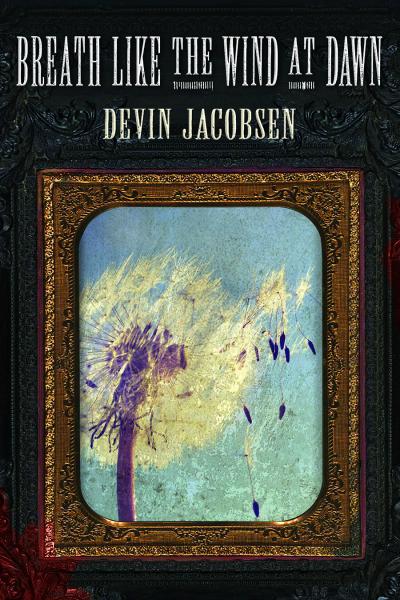Devin Jacobsen: Breath Like the Wind at Dawn review – the disturbances of the Civil War | reviews, news & interviews
Devin Jacobsen: Breath Like the Wind at Dawn review – the disturbances of the Civil War
Devin Jacobsen: Breath Like the Wind at Dawn review – the disturbances of the Civil War
A burningly lyrical portrait of American hate, harm and horror

How do you imagine the wind at dawn? Biting, brisk, peremptory – a kind of summons as another day begins?
For Les Tamplin, wife-beater, sheriff, father to three sons, it is a detective, deathly wind, "the wind that cannot be stopped" which stirs with the ghosts of all he’s killed, "come to steal [his] last breath". Since the Civil War, he has murdered compulsively, following "the urgent need to choke" for the relief it brings. The wind stalks him with the threat of retribution. It is lithe and fleshly, and "comes crawling at me on its belly like an infant’s slow slithering". He is certain it will reach him one day, this breath of the dead. Yet despite his apprehension of "that trickle of dark wind", the book is not about Les’s attempt to outrun his ghosts. He looks forward to meeting them, to "the final You that releases me".
Does this make the book about punishment for dark deeds, or deliverance from them? Neither, it seems. Spanning the beginning of the American Civil War and the decade or so afterwards, Jacobsen’s debut is interested in exploring the imprint of that violent period, the way it disturbed individuals, familial relationships and chains of association, tracing its devastation on the unit of the Tamplin family: the mother Annora, eldest son Edward, twins Irving and Quinn, and father Les. Writing in the tradition of William Faulkner and Cormac McCarthy, Jacobsen’s portrait is unsparing even as it is lyrical, its pages filled with blasted flesh and "ruining face[s]", of bodily harm, rape, and disregard for human life stretched to its furthest limit. Violence here seems learned more than it is inherited, but spreads with vicious ease. The choice to focus on a family, whose members supply the kaleidoscope of narrative perspectives, seems designed to expose the extent of the wreckage. Not even the bonds of kin can hold.
 Misrecognition of family members, which takes place repeatedly, works to underline this. The novel opens with an anecdote about "a drafty door of a fellow" who set out to play a prank on his mother and sister by pretending to be a rich Yankee "about to surprise his own ma and sister when he sees them flush with cash in a few days hence". Before he has the chance to reveal himself and bring the joke to its conclusion, they slit his throat in the dead of night and seize all his cash. What is here orchestrated as intentional disguise gone wrong (a kind of farce), replays itself as tragedy later in the book, though the sense of irony lingers. The twins fail to recognise their elder brother. Les unwittingly shoots his son in the face. Only Edward, the least bloodthirsty, seems able to identify his kin, even when they are badly mutilated – his mother’s body "transformed to a bloody gown". The effect of this is to suggest some kind of parallel between the warping effects of persistent violence and the erasure of the past. Recognition is bound up with acceptance as well as perception. The other Tamplins are not alert to their shared history, instead existing provisionally within the net of suspicion and enmity, bred by the divide between North and South.
Misrecognition of family members, which takes place repeatedly, works to underline this. The novel opens with an anecdote about "a drafty door of a fellow" who set out to play a prank on his mother and sister by pretending to be a rich Yankee "about to surprise his own ma and sister when he sees them flush with cash in a few days hence". Before he has the chance to reveal himself and bring the joke to its conclusion, they slit his throat in the dead of night and seize all his cash. What is here orchestrated as intentional disguise gone wrong (a kind of farce), replays itself as tragedy later in the book, though the sense of irony lingers. The twins fail to recognise their elder brother. Les unwittingly shoots his son in the face. Only Edward, the least bloodthirsty, seems able to identify his kin, even when they are badly mutilated – his mother’s body "transformed to a bloody gown". The effect of this is to suggest some kind of parallel between the warping effects of persistent violence and the erasure of the past. Recognition is bound up with acceptance as well as perception. The other Tamplins are not alert to their shared history, instead existing provisionally within the net of suspicion and enmity, bred by the divide between North and South.
The book is slim at 200 pages, but dense despite that, its idiom complex in its recreation of 19th-century language: elaborate syntax, knotted imaginings, shifts in perspective unannounced and pronouns often determinedly vague. Its opening lines, for example: "Yonder they lay: a tangle the like of fleas. They that we had sought since long before sunup this morning hovered a bit and sank from the horizon." Such rich-textured prose rewards re-reading, but in the first chapters, when explanatory cues are particularly important, it can feel slightly impenetrable. Still, the book grows into itself as it continues, and its difficulty is also one of its strengths. Bracketing the novel are two stylistically daring passages that create a dizzying, incantatory blend of first-, second- and third-person (reminiscent of Faulker’s The Sound and the Fury) that bewilder normative grammar and reclaim the sentence as an active, generative form. These chapters are also important for staging the novel’s provocative ambivalence on the subject of evil, Annora responding to devilish "chirps and jitters", to a skittish creature that is like a "first-dayed babe", "skin so frail like a hand-me-down or some bobbin-net too rich for use", "quicked in sucks of blood". Is this an incarnation of her husband, or something more pervasive, more urgent, more strange?
Breath Like the Wind at Dawn is not a perfect novel, but it is an impressive, stretchingly inventive one, whose intensity will linger with you long after its close. Devin Jacobsen is only just beginning to show what he can do. I look forward to what’s next.
- Breath Like the Wind at Dawn by Devin Jacobsen (Sagging Meniscus Press, £18.99)
- More books on theartsdesk
rating
Share this article
The future of Arts Journalism
You can stop theartsdesk.com closing!
We urgently need financing to survive. Our fundraising drive has thus far raised £49,000 but we need to reach £100,000 or we will be forced to close. Please contribute here: https://gofund.me/c3f6033d
And if you can forward this information to anyone who might assist, we’d be grateful.

Subscribe to theartsdesk.com
Thank you for continuing to read our work on theartsdesk.com. For unlimited access to every article in its entirety, including our archive of more than 15,000 pieces, we're asking for £5 per month or £40 per year. We feel it's a very good deal, and hope you do too.
To take a subscription now simply click here.
And if you're looking for that extra gift for a friend or family member, why not treat them to a theartsdesk.com gift subscription?
more Books
 'We are bowled over!' Thank you for your messages of love and support
Much-appreciated words of commendation from readers and the cultural community
'We are bowled over!' Thank you for your messages of love and support
Much-appreciated words of commendation from readers and the cultural community
 Thomas Pynchon - Shadow Ticket review - pulp diction
Thomas Pynchon's latest (and possibly last) book is fun - for a while
Thomas Pynchon - Shadow Ticket review - pulp diction
Thomas Pynchon's latest (and possibly last) book is fun - for a while
 Justin Lewis: Into the Groove review - fun and fact-filled trip through Eighties pop
Month by month journey through a decade gives insights into ordinary people’s lives
Justin Lewis: Into the Groove review - fun and fact-filled trip through Eighties pop
Month by month journey through a decade gives insights into ordinary people’s lives
 Joanna Pocock: Greyhound review - on the road again
A writer retraces her steps to furrow a deeper path through modern America
Joanna Pocock: Greyhound review - on the road again
A writer retraces her steps to furrow a deeper path through modern America
 Mark Hussey: Mrs Dalloway - Biography of a Novel review - echoes across crises
On the centenary of the work's publication an insightful book shows its prescience
Mark Hussey: Mrs Dalloway - Biography of a Novel review - echoes across crises
On the centenary of the work's publication an insightful book shows its prescience
 Frances Wilson: Electric Spark - The Enigma of Muriel Spark review - the matter of fact
Frances Wilson employs her full artistic power to keep pace with Spark’s fantastic and fugitive life
Frances Wilson: Electric Spark - The Enigma of Muriel Spark review - the matter of fact
Frances Wilson employs her full artistic power to keep pace with Spark’s fantastic and fugitive life
 Elizabeth Alker: Everything We Do is Music review - Prokofiev goes pop
A compelling journey into a surprising musical kinship
Elizabeth Alker: Everything We Do is Music review - Prokofiev goes pop
A compelling journey into a surprising musical kinship
 Natalia Ginzburg: The City and the House review - a dying art
Dick Davis renders this analogue love-letter in polyphonic English
Natalia Ginzburg: The City and the House review - a dying art
Dick Davis renders this analogue love-letter in polyphonic English
 Tom Raworth: Cancer review - truthfulness
A 'lost' book reconfirms Raworth’s legacy as one of the great lyric poets
Tom Raworth: Cancer review - truthfulness
A 'lost' book reconfirms Raworth’s legacy as one of the great lyric poets
 Ian Leslie: John and Paul - A Love Story in Songs review - help!
Ian Leslie loses himself in amateur psychology, and fatally misreads The Beatles
Ian Leslie: John and Paul - A Love Story in Songs review - help!
Ian Leslie loses himself in amateur psychology, and fatally misreads The Beatles
 Samuel Arbesman: The Magic of Code review - the spark ages
A wide-eyed take on our digital world can’t quite dispel the dangers
Samuel Arbesman: The Magic of Code review - the spark ages
A wide-eyed take on our digital world can’t quite dispel the dangers
 Zsuzsanna Gahse: Mountainish review - seeking refuge
Notes on danger and dialogue in the shadow of the Swiss Alps
Zsuzsanna Gahse: Mountainish review - seeking refuge
Notes on danger and dialogue in the shadow of the Swiss Alps

Add comment